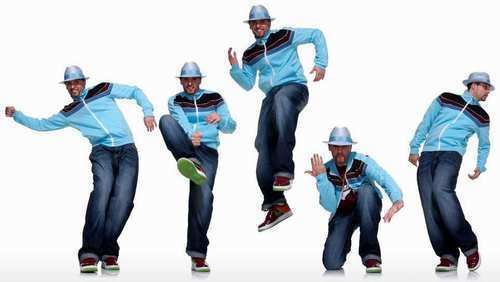 | ||
Similar Crip Walk, Krumping, Robot (dance) | ||
Locking is a style of funk dance, which is today also associated with hip hop. The name is based on the concept of locking movements, which basically means freezing from a fast movement and "locking" in a certain position, holding that position for a short while and then continuing in the same speed as before. It relies on fast and distinct arm and hand movements combined with more relaxed hips and legs. The movements are generally large and exaggerated, and often very rhythmic and tightly synced with the music. Locking is quite performance oriented, often interacting with the audience by smiling or giving them a high five, and some moves are quite comical in nature. A dancer who performs locking is called a locker. Lockers commonly use a distinctive dress style, such as colorful clothing with stripes and suspenders.
Contents
Locking was originally danced to traditional funk music, such as that produced or performed by James Brown. Funk music is still commonly favored by locking dancers, and used by many competitions such as the locking division of Juste Debout. Locking movements create a strong contrast towards the many fast moves that are otherwise performed quite continuously, combined with mime style performance and acting towards the audience and other dancers. Locking includes quite a lot of acrobatics and physically demanding moves, such as landing on one's knees and the split. These moves often require knee protection of some sort.
History
The beginning of Locking can be traced to one man, Don Campbell. In the late 1960s he put together several fad dances adding moves of his own (known as the "Lock") when performing. The original lock was created by accident: Don Campbell couldn't do a move called the 'The Funky Chicken' and stopped at a particular point whilst moving his arms, creating a 'locking' effect. He wasn't able to perform it fluently, for he couldn't remember which step to take next. (Even the acting towards the audience was spontaneous: when people started laughing at Don because of his unfamiliar moves, he responded by pointing at them.) These halts soon became popular as Don added them into his performances. The resulting dance was called Campbellocking, which was later shortened to Locking. In the early 1970s this set off a movement of Locking dance groups, notably Campbell's group The Lockers. Other lockers Jimmy "Scoo B Doo" Foster, Greggory "Campbellock Jr." Pope, Tony "GoGo" Lewis, Fred "Mr Penguin" Berry (a.k.a. Rerun), Leo "Fluky Luke" Williamson, Damita Jo Freeman and others also helped set the foundation for the locking dance and clothes style.
Clothes style can consist of loud striped socks, pegged pants that stopped at the knees, bright colorful satin shirts with big collars, big colorful bow ties, gigantic Apple Boy hats, and white gloves.
Moves
Locking may be done in solo or in unison with two or more dancers doing steps or handshakes together. A locker may smile while performing to emphasize the comical nature of the dance; other times, a serious demeanor will be maintained to place emphasis on technique. Other important stylistic features are waving of arms, pointing, walking stationary and grabbing and rotating the cap or hat. Don Campbell created the original freezes, incorporating his unique rhythm and adding gestures such as points and handclaps. Other dancers also adapted this style while creating other steps and moves.
Locking is by nature an improvisational dance but also consists of a set of signature moves of locking pioneers, However, many lockers alter or blend these with other moves or create their own variations. In general, Lockers will often put a small pause and move up on the second and fourth beats to emphasize the locking.
Up Lock (Muscle man)
A macho man pose, where the arms are drawn above the shoulder. The pose is generally held for a moment or two.